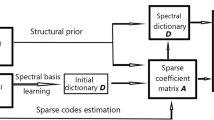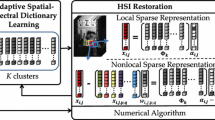Abstract
This paper proposed a hyperspectral (HS) and multispectral (MS) image fusion method based on superpixel guided structure sparsity and couple dictionary (SGSSCD). It is assumed that the pixels in a homogeneous area of MS image are similar due to the consistent spatial consistency. Superpixel technique is used to find the similar pixels in MS image by considering the region homogeneity. Then these pixels naturally share the same atoms in low spectral resolution dictionary. In order to capture the similarity prior, structural sparsity is employed to find more efficient coding of the similar pixels in MS image over low spectral resolution dictionary. Finally, high spatial resolution HS image can be produced by combining the codes of MS image with high spectral resolution dictionary. Besides, the couple dictionary is learned from HS and low spatial resolution MS images to ensure the spectral correspondence, which can further improve the quality of fusion results. The experimental results on different datasets demonstrate the effectiveness of the proposed method when compared with some existing methods.






Similar content being viewed by others
References
Achanta R, Shaji A, Smith K et al (2012) SLIC superpixels compared to state-of-the-art superpixel methods. IEEE Trans Pattern Anal Mach Intell 11:2274–2282
Aharon M, Elad M, Bruckstein A (2006) K-SVD: an algorithm for designing overcomplete dictionaries for sparse representation. IEEE Trans Signal Process 11:4311–4322
Aiazzi B, Baronti S, Lotti F et al (2009) A comparison between global and context-adaptive pansharpening of multispectral images. IEEE Geosci Remote Sens Lett 2:302–306
Akhtar N, Shafait F, Mian A (2014) Sparse spatio-spectral representation for hyperspectral image super-resolution. Proc ECCV, pp 63–78
Akhtar N, Shafait F, Mian A (2015) Bayesian sparse representation for hyperspectral image super resolution. Proc IEEE CVPR, pp 3631–3640
Amro I, Mateos J, Vega M et al (2011) A survey of classical methods and new trends in pansharpening of multispectral images. EURASIP J Advan Signal Process 2011(1):79
Ankarao V, Sowmya V, Soman KP (2018) Multi-sensor data fusion using NIHS transform and decomposition algorithms. Multimed Tools Appl 23:30381–30402
Bioucasdias J, Plaza A, Campsvalls G et al (2013) Hyperspectral remote sensing data analysis and future challenges. IEEE Geosci Remote Sens Mag 1(2):6–36
Campsvalls G, Bruzzone L (2005) Kernel-basted methods for hyperspectral image classification. IEEE Trans Geosci Remote Sens 6:1351–1362
Candès EJ, Li X, Ma Y, Wright J (2009) Robust principal component analysis? J ACM 1:1–37
Chang X, Ma Z, Lin M et al (2017) Feature interaction augmented sparse learning for fast kinect motion detection. IEEE Trans Image Process 8:3911–3920
Chavez PS, Sides SC, Anderson JA (1991) Comparison of three different methods to merge multiresolution and multispectral data: Landsat TM and SPOT panchromatic. Photogramm Eng Remote Sens 3:265–303
Chen HY, Leou JJ (2012) Multispectral and multiresolution image fusion using particle swarm optimization. Multimed Tools Appl 3:495–518
Chen Z, Pu HY, Wang B et al (2014) Fusion of hyperspectral and multispectral images: a novel framework based on generalization of pan-sharpening methods. IEEE Geosci Remote Sens Lett 8:1418–1422
Conn AR, Gould NIM, Toint PL (1991) A globally convergent augmented Lagrangian algorithm for optimization with general constraints and simple bounds. Siam J Num Anal 2:545–572
Hancock GR, Freeman MJ (2001) Power and sample size for the root mean square error of approximation test of not close fit in structural equation modeling. Educ Psychol Meas 5:741–758
Kanmani M, Narasimhan V (2016) An optimal weighted averaging fusion strategy for thermal and visible images using dual tree discrete wavelet transform and self tunning particle swarm optimization. Multimed Tools Appl 20:1–22
Kawakami R, Wright J, Tai YW (2011) High-resolution hyperspectral imaging via matrix factorization. Proc IEEE CVPR, pp 2329–2336
Kunkel B, Blechinger F, Viehmann D et al (1991) ROSIS imaging spectrometer and its potential for ocean parameter measurements (airborne and space-borne). Int J Remote Sens 4:753–761
Li Z, Nie F, Chang X et al (2017) Beyond trace ratio: weighted harmonic mean of trace ratios for multiclass discriminant analysis. IEEE Trans Knowl Data Eng 10:2100–2110
Lin B, Tao X, Duan Y et al (2018) Hyperspectral and multispectral image fusion based on low rank constrained gaussian mixture model. IEEE Access 6:16901–16910
Liu M Y, Tuzel O, Ramalingam S et al (2011) Entropy rate superpixel segmentation. Proc IEEE CVPR, pp 2097–2104
Mangalraj P, Agrawal A (2017) Novel approach on fusion of multisensor images based on neutrosophic domain in consideration of regional relevance. Multimed Tools Appl 1:1–18
Nasrabadi NM (2013) Hyperspectral target detection: an overview of current and future challenges. IEEE Signal Process Mag 1:34–44
Nezhad ZH, Karami A, Heylen R et al (2016) Fusion of hyperspectral and multispectral images using spectral unmixing and sparse coding. IEEE J Sel Topics Appl Earth Obser Remote Sens 6:2377–2389
Paramanandham N, Rajendiran K (2017) Multi sensor image fusion for surveillance applications using hybrid image fusion algorithm. Multimed Tools Appl 7:1–32
Schweizer SM, Moura JMF (2001) Efficient detection in hyperspectral imagery. IEEE Trans Image Process 4:584–597
Selva M, Aiazzi B, Butera F et al (2017) Hyper-sharpening: a first approach on SIM-GA data. IEEE J Sel Topics Appl Earth Obser Remote Sens 6:3008–3024
Shen J, Du Y, Wang W et al (2014) Lazy random walks for superpixel segmentation. IEEE Trans Image Process 4:1451–1462
Stein DWJ, Beaven SG, Hoff LE et al (2002) Anomaly detection from hyperspectral imagery. IEEE Signal Process Mag 1:58–69
Veganzones MA, Simoes M, Licciardi G et al (2016) Hyperspectral super-resolution of locally low rank images from complementary multisource data. IEEE Trans Image Process 1:274–288
Vivone G, Alparone L, Chanussot J et al (2015) A critical comparison among pansharpening algorithms. IEEE Trans Geosci Remote Sens 5:2565–2586
Wald L (2000) Quality of high resolution synthesised images: is there a simple criterion? Proc. Int. Conf. Fusion Earth Data, Nice, France, pp 99–103
Wald L, Ranchin T, Mangolini M (1997) Fusion of satellite images of different spatial resolutions: assessing the quality of resulting images. Photogramm Eng Remote Sens 63:691–699
Wang Z, Bovik AC (2002) A universal image quality index. IEEE Signal Process Lett 3:81–84
Wei J, Huang Y (2017) NMPE: a normalized metric for measuring generalized spatial distortion of multispectral panshapening fusion. Multimed Tools Appl 4:1–18
Wei Q, BioucasDias José M, Dobigeon N et al (2015) Hyperspectral and multispectral image fusion based on a sparse representation. IEEE Trans Geosci Remote Sens 7:3658–3668
Wei Q, Dobigeon N, Tourneret JY (2015) Fast fusion of multi-band images based on solving a Sylvester equation. IEEE Trans Image Process 11:1632–1636
Yokoya N, Yairi T, Iwasaki A (2012) Coupled nonnegative matrix factorization unmixing for hyperspectral and multispectral data fusion. IEEE Trans Geosci Remote Sens 2:528–537
Yuhas RH, Goetz AFH, Boardman JW (1992) Discrimination among semi-arid landscape endmembers using the Spectral Angle Mapper (SAM) algorithm. Proc. Summaries 4th JPL Airborne Earth Sci. Workshop, pp 147–149
Zhang K, Wang M, Yang S (2017) Multispectral and hyperspectral image fusion based on group spectral embedding and low-rank factorization. IEEE Trans Geosci Remote Sens 3:1363–1371
Zhang K, Wang M, Yang S et al (2018) Spatial–spectral-graph-regularized low-rank tensor decomposition for multispectral and hyperspectral image fusion. IEEE J Sel Topics Appl Earth Obser Remote Sens 4:1030–1040
Zhu XX, Bamler R (2013) A sparse image fusion algorithm with application to pan-sharpening. IEEE Trans Geosci Remote Sens 5:2827–2836
Zhu XX, Claas G, Bamler R (2016) Exploiting joint sparsity for pansharpening: the J-SparseFI algorithm. IEEE Trans Geosci Remote Sens 5:2664–2681
Author information
Authors and Affiliations
Corresponding author
Additional information
Publisher’s Note
Springer Nature remains neutral with regard to jurisdictional claims in published maps and institutional affiliations.
Rights and permissions
About this article
Cite this article
Zhang, F., Zhang, K. Superpixel guided structure sparsity for multispectral and hyperspectral image fusion over couple dictionary. Multimed Tools Appl 79, 4949–4964 (2020). https://doi.org/10.1007/s11042-019-7188-1
Received:
Revised:
Accepted:
Published:
Issue Date:
DOI: https://doi.org/10.1007/s11042-019-7188-1




